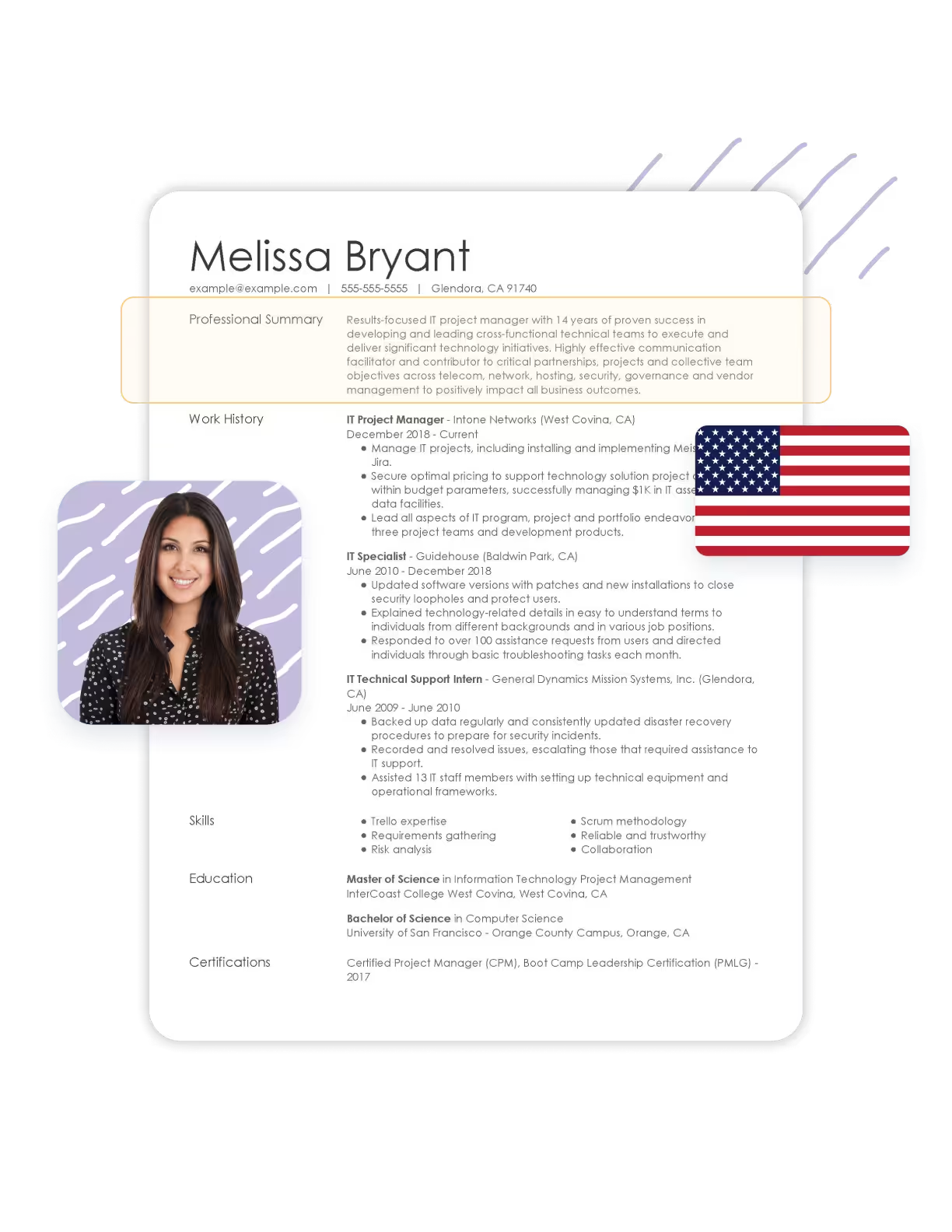So, you’re on the hunt for a job in the US? The first step is crafting a standout US resume.
But before making your US resume, you need to know what makes an American resume effective, from choosing the right format to highlighting your achievements in a way that resonates with US employers.
This guide on American resumes will explore:
- Choosing the right US resume format for your career stage.
- How to write an American resume that recruiters love.
- What to leave off of your US resume.
- Key takeaways to keep in mind during your job search.
Are you working on your US resume? Our AI Resume Builder can make it effortless. Just enter your job title, and you’ll get tailor-made text for every part of your resume, ensuring it aligns perfectly with the expectations for resumes in the United States.
Related Guides & Tips
Browse other popular samples
US resume sample
The following example gives you a basic idea of what a USA resume looks like. After that, we will give you a section-by-section breakdown of how to write one.
One thing to keep in mind — the US resume is the equivalent of a European CV. Despite the name difference, they are the same document.
How to write an American resume
Starting your job search in the US requires a well-crafted resume that stands out to employers.
This guide will walk you through each step of creating an effective US resume, ensuring that you present your qualifications and experiences in the best possible light.
We’ll cover the following:
- Choosing a US resume format.
- Adding contact info to your header.
- Summarizing your career.
- Laying out a job history section.
- Highlighting your education.
- Filling your resume with skills.
- Optimizing for keywords.
- Including a cover letter.
Let’s check out the first step: selecting the right format for your application.
1. Choose a US resume format
There are a few resume formats popular in the U.S., and picking the right one can really help show off your strengths. Whether you’ve worked for years or are just starting out, there’s a format that fits your needs.
- Chronological resume formats are the most common. They list your jobs starting with the most recent one. This format works well if you’ve been working steadily for years and want to show off a clear career path.
- Functional resume formats focus on your skills instead of where you’ve worked and when. This is great for people who are changing careers, have had breaks in their work history or are new to the job market. It lets you highlight what you can do, not just where you’ve done it.
- Combination resume format mixes the best parts of chronological and functional resumes. You start with your skills and achievements, then list your jobs in reverse order. This format is perfect for those with lots of experience and skills who also want to show a solid work history.
With these formats in mind, let’s look at some tips to make sure your resume looks good and reads well.
US resume-formatting tips
Knowing how to format a resume is just as important as having good content. A chaotic and unprofessional design might turn off employers in the US.
Here are few tips to help you make your resume look good:
- Start with a template: Choosing a resume template gives you a structured starting point to organize your information clearly. It saves time and ensures your resume looks polished, whether you’re using a simple design or something more creative.
- Keep standard margins: Set your resume margins to 1 inch on all sides for a tidy layout. If you need more space, you can slightly reduce them, but avoid going below half an inch to keep your resume readable.
- Choose a simple font: Stick to classic, easy-to-read fonts like Times New Roman or Arial, in 12-point size for the body of your resume. Use black font color for consistency, and remember, using just one font type keeps your resume looking professional.
- Use clear section headings: Organize your resume with clear headings for each section: Contact Information, Professional Summary or Resume Objective, Work Experience, Education and Skills. Add other relevant sections like Volunteer Work or Certifications if they enhance your application.
- Ensure an easy-to-read layout: Align your text to the left for a clean, formal look. Use bullet points to list your experiences and skills, making your resume easy to skim and understand at a glance.
Pro tip:US resumes are between one and two pages long, depending on your experience level. If you’re early in your career or have less than 10 years of experience, aim to keep your resume to one page. For those with more extensive experience, a two-page resume can provide the space needed.
2. Add contact info in your header
You want employers to reach you easily, right?
You need a clear header with easy-to-read contact info.
Here’s what you should include in your header:
- Name: Your full name, prominently placed at the top.
- Phone number: A current phone number where you can be easily reached.
- Email address: A professional email address, ideally based on your name.
- LinkedIn profile: If you have a LinkedIn profile, include the URL (make sure it’s updated).
- Location: Your city and state. Full address is not necessary.
Here’s what you shouldn’t include in your header when applying for jobs in the U.S.:
- Full home address: Just city and state are enough for privacy reasons and relevancy.
- Date of birth: Age is not a factor for your ability to perform most jobs.
- Social Security number (SSN): For security reasons, never include this.
- Personal details: Such as marital status, nationality or a photo, which are not relevant to your job qualifications and can introduce bias.
With your contact information clearly outlined, let’s move on to introducing yourself in a way that captures the employer’s interest right from the start.
3. Introduce yourself with a summary
At the top of your U.S. resume, you should include a three- to five-sentence paragraph. This is called a resume profile, and there are different types suiting different circumstances.
Most job seekers would be satisfied by a resume summary. These are brief overviews of your professional experience, major achievements and skills. They are best suited for job seekers with some experience in their field, as they highlight your career peaks and key strengths in a brief form.
Note: If you want to make a summary in just a few clicks, give our AI Resume Summary Generator a try.
For others, a resume objective may be a better idea. These are statements about your career goals and how you can benefit the company. Objectives are ideal for those new to the workforce, changing careers or with gaps in their employment history. They focus on your ambitions and how they align with the company’s goals.
Now, let’s look at these types of profiles in action. Here’s what a summary looks like:
Experienced marketing professional with over 10 years of experience in digital and traditional marketing. Proven track record of increasing website traffic by 50% for ABC Corp. and growing online sales by 30% for XYZ Ltd. Skilled in strategic planning, content creation and SEO optimization. Adept at leading teams to achieve company goals and enhance brand visibility.
Here’s what an objective statement looks like:
Motivated and creative graphic designer seeking to leverage two years of freelance experience and a bachelor’s degree in graphic design to contribute to innovative design projects at Creative Co. Passionate about visual storytelling and eager to bring fresh ideas and a unique perspective to your team.
Now that we’ve covered how to introduce yourself on your resume, let’s move into detailing your work history.
4. Lay out your work history
The biggest section in most US resumes is job history. Here, you list your previous roles, starting with the most recent.
But you don’t simply recite what you did. Instead, you list your most relevant and impressive accomplishments in each position, using bullet points to make it easier to read at a glance.
Here’s what an entry in a U.S. work experience section for a marketing professional might look like:
Digital Marketing Manager, Hearst
New York, NY (June 2018 – Present)
- Spearhead a digital campaign that has increased website traffic by 40% within six months.
- Lead a team of five to execute social media strategies, resulting in a 50% increase in engagement to date.
- Manage a budget of $200,000, optimizing spend and saving the company 10% annually.
- Collaborate with the sales team to develop lead generation strategies that so far have boosted leads by 30%.
Pro tip:Use action verbs such as “Spearheaded,” “Led,” “Managed” and “Collaborated” at the start of your bullet points to make your contributions stand out and convey a sense of initiative and leadership.
5. Highlight your education
Making an education section can be tricky when you’re applying for jobs from outside the U.S.
The types of degrees available and what they mean might not be immediately clear to employers.
If you have qualifications in a different country, mention any equivalencies or how they relate to U.S. standards.
Highlight any U.S.-based certifications or licenses relevant to the job.
Here’s what this might look like:
Engineer’s Degree in Informatics, Politecnico di Milano, Italy (U.S. Equivalent: Master of Science in Computer Science)
- Specialization in Software Engineering, graduated Summa Cum Laude, 2020
Certified Scrum Master (CSM), Scrum Alliance
- Earned certification in 2020, demonstrating expertise in Agile project management practices.
Cisco Certified Network Associate (CCNA), Cisco
- Acquired in 2021, validating foundational networking knowledge and skills.
6. Fill your US resume with skills
Many skills translate from industry to industry, and even country to country. They are your key between a wide range of places and professions.
As an essential resume ingredient, there are a couple of different ways to add skills to your resume.
Add your skills in dedicated sections. This section should be a concise list of your abilities that are most relevant to the job you’re applying for. You can have a ‘Computer Skills’ section for hard skills and a ‘Key Competencies’ section for soft skills. This makes it easy for employers to quickly see if you have the skills they need.
Add skills throughout your resume, from the professional summary to the bullet points in your work history. This helps to contextually show how you’ve applied these skills in real-world situations, enhancing the narrative of your professional accomplishments.
Which types of skills should you add? Well, that really depends on the job.
Some occupations rely heavily on technical skills, while others, such as service-sector roles, utilize more soft skills. Let’s look at examples of different skill types.
Here are some hard skills often found on US resumes:
- Data analysis
- Software proficiency (e.g., Adobe Creative Suite, Microsoft Office Suite)
- Programming languages (e.g., Python, Java, C++)
- Project management (e.g., Agile, Scrum)
- Foreign language proficiency
- SEO/SEM marketing
- Cloud computing
- Social media management and digital marketing
- Graphic design
Here are some soft skills often found on US resumes:
- Communication
- Leadership
- Problem-solving
- Time management
- Adaptability
- Teamwork
- Creativity
- Attention to detail
- Customer service
Bear in mind, this isn’t a showdown between hard skills and soft skills. Rather, the most well-rounded candidates have a mix of both skill types.
Next, we’ll show you how to use keywords to optimize your resume for employers in the U.S.
7. Optimize for keywords
In the U.S., 97% of Fortune 500 companies use software that screens resumes for specific keywords. These programs are called applicant tracking systems (ATS) and can make or break your chances of getting an interview.
So, when you’re done with your first draft, go back to make sure your resume is ATS-friendly by including the right keywords. To do this, read the job description closely, and highlight any keywords you come across.
Here’s a job description for a customer service representative, with the keywords in bold:
We are looking for a dedicated customer service representative to assist our clients efficiently. The ideal candidate will have strong communication skills, the ability to resolve customer complaints and a background in customer support. Responsibilities include managing customer queries, maintaining customer satisfaction and using CRM software to log all interactions. Preferably with bilingual abilities and experience in a call center environment.
Once you have the keywords, revisit your resume to find places where the keywords make sense. Here’s a professional summary using some of the keywords found above:
Experienced customer service representative with a track record of enhancing customer satisfaction through exceptional communication and efficient resolution of complaints. Proficient in managing customer queries and adept at using CRM software to document interactions comprehensively. Demonstrated ability to work effectively in fast-paced call center environments. Fluent in English and Spanish, offering bilingual support to meet diverse customer needs.
One final step many job seekers in the U.S. take — writing a cover letter.
8. Consider adding a cover letter
In the U.S., cover letters are often included with a resume.
They give you an advantage over other candidates for several reasons, including:
- Adding a personal touch: A cover letter allows you to introduce yourself in a more personal manner, going beyond the bullet points of your resume to tell a compelling story about your career journey and aspirations. This personal touch can make you more memorable to hiring managers.
- Explaining your circumstances: If you have gaps in your employment, are changing careers or have other unique situations (i.e., you’re looking to relocate or get a promotion), a cover letter provides an opportunity to explain these circumstances in a positive light, directly addressing potential concerns employers may have.
- Demonstrating interest in the company: Writing a cover letter gives you a chance to show that you’ve done your homework about the company and the role. You can tailor your letter to reflect how your skills and experiences make you an ideal fit for the position and how you align with the company’s values and goals.
Pro tip:Consider using a cover letter template that matches your resume to create a cohesive and professional appearance for your application materials.
That’s all it takes to write a great US resume. Before we go, just to be safe, we’ll show you what to omit from your resume.
What to leave off your US resume
When crafting your US resume, you want to know what to include and what to leave out.
Certain details that might be standard or expected in resumes from other countries can be counterproductive or even frowned upon in the United States.
Here’s what you should leave off your US resume:
- Personal address — Given privacy concerns and the irrelevance of proximity in many jobs, especially with the rise of remote work, your full home address is unnecessary. It’s sufficient to list your city and state to provide a general idea of your location.
- Photo — While common in other countries, in the U.S., it’s generally not customary to include a photograph unless you’re applying for roles in certain creative industries or acting. Including a photo can inadvertently lead to bias in the hiring process.
- Age or date of birth — Age is not a factor in determining your ability to perform a job. Including this information can lead to age discrimination. It’s best to focus on your experience and skills.
- Social Security number (SSN) — For security reasons, never include your SSN on your resume. Employers do not need this information until the later stages of the hiring process, typically for a background check after a job offer.
- Salary history — Disclosing your previous or current salary can negatively impact your ability to negotiate a fair salary. Focus on your skills and the value you bring to the potential employer.
- Reasons for leaving previous jobs — The resume is not the place to explain why you left or are leaving a job. This can be discussed in your cover letter or during the interview if necessary.
- Marital status or family details — This information is not relevant to your application and can lead to discrimination. Employers in the U.S. are focused on your professional qualifications.
- Religious or political affiliations — Unless you’re applying for a position within a religious or political organization where such information might be relevant, it’s advisable to leave these details out to avoid potential bias.
- References — Listing references on your resume is no longer common practice. In fact, don’t even include the line “References Available Upon Request.” Instead, create a separate document where you list the names and details of three or four references the employer can follow up on to share if prompted further down the line.
OK, let’s wrap up with some takeaways to help you throughout your career journey.
USA resume — key takeaways
-
Choose the right US resume format
Select a chronological, functional or combination format based on your career history and goals.
-
Optimize your header
Include essential contact information, but leave out personal details like your full address or SSN for privacy and relevance.
-
Detail your work history with achievements
Focus on accomplishments in your job history using action verbs and quantifiable results to demonstrate your impact.
-
Highlight your education appropriately
For degrees from outside the U.S., clarify their U.S. equivalency and focus on relevant certifications or licenses.
-
Use keywords effectively
Tailor your resume with keywords from the job description to pass ATS scans and appeal to hiring managers.
-
Include a cover letter
Complement your resume with a cover letter that adds a personal touch, explains unique circumstances and demonstrates interest in the company.
-
Keep design consistent
Use matching templates for your resume and cover letter for a cohesive and professional look.
Was this information about How To Make A US Resume (Format, Template + Examples) helpful? Let us know!
Don is a Certified Professional Resume Writer (CPRW) with more than 10 years’ experience creating digital content, including four years helping job seekers develop their careers. He holds an M.S. in Journalism from Northwestern University.
More resources

Hobbies and Interests to Put on Your Resume: Examples & Guide
Showcase individuality and drive by putting hobbies and intere...

How to List Relevant Coursework on a Resume (With Examples)
Wondering how to list relevant coursework on a resume to show ...

Biotechnologist: Examples, Templates & Tips for 2025
Dreaming of becoming a biotechnologist? Check out our easy-to-...

Construction Manager Resume: Examples, Templates & Tips for 2025
Set the foundation for a successful 2024 in your construction ...

Business Process Analyst Resume: Examples, Templates & Tips for 2025
Looking for a job as a business process analyst? Find the perf...


